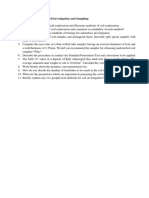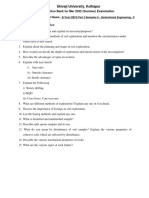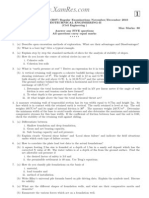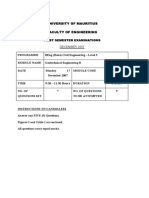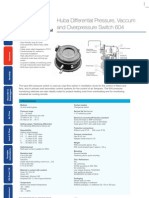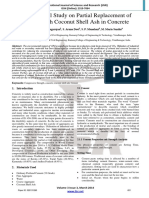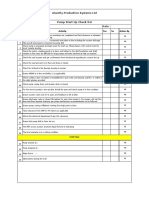Student Self-Led Activity Exercises On Supported Vertical Sided Excavations
Student Self-Led Activity Exercises On Supported Vertical Sided Excavations
Uploaded by
Zaid AlsarayrehCopyright:
Available Formats
Student Self-Led Activity Exercises On Supported Vertical Sided Excavations
Student Self-Led Activity Exercises On Supported Vertical Sided Excavations
Uploaded by
Zaid AlsarayrehOriginal Description:
Original Title
Copyright
Available Formats
Share this document
Did you find this document useful?
Is this content inappropriate?
Report this DocumentCopyright:
Available Formats
Student Self-Led Activity Exercises On Supported Vertical Sided Excavations
Student Self-Led Activity Exercises On Supported Vertical Sided Excavations
Uploaded by
Zaid AlsarayrehCopyright:
Available Formats
Student self-led activity exercises on Supported vertical sided excavations
1. 3. A 3.5 m deep excavation in cohesionless soil is to be supported by cantilever sheet
piles. The soil characteristics are: ′ = 34, c′ = 0 and = 19 kN/m3.
Estimate the length of pile to be driven into the ground by the two methods described in
the hand out (Method 1 – The Factored Moment Method (FMM) and Method 2 – The
Factored Strength Method (FSM), then through a check decide which value to go for and
give the reason why. For both methods use design partial factor of 2. (Ans: d = 5m FMM
and d = 7.6m)
2. An anchored sheet-pile wall retains soil of height 6 m, the pile having a total length of
9.75 m. The soil has a bulk unit weight of 19 kN/m3, a negligible cohesion and an angle
of shearing resistance of 30. The anchor tie-rods are at 1.25 m below the surface of the
soil winched to a grouted concrete mass.
(i) Find the active thrust on the piling in kN per horizontal metre (Ans: 301 kN/m).
(ii) Determine the fraction contribution of the anchor to the limiting state passive
resistance on the embedded length of the sheet-pile to balance the active thrust,
assuming the free earth support system. (Ans: 0.54)
(iii) Find the tension in the anchor (Ans: 83.1kN
(iv) Find the total pull force on the anchor if they are spaced at 3m (Ans: 249.24kN).
(v) If the anchor has a diameter of 0.5m, determine the length of the grout anchor. (Ans:
11.57m)
(vi) Support your answer with clearly labelled diagrams.
3. Find the length of a sheet pile wall required to retain 4 m of soil, which has a surcharge of
10 kN/m2/m acting on the surface. The surface is horizontal and the water table is several
metres below the retained level. Assume c' = 0 kPa; ' = 30° and = 20 kN/m3. (Ans:
8.92m)
4. A trench 2.5 m wide and 5.5 m deep is to be excavated in compact dry sand, in order to
place a 500 mm diameter pipeline with centre at 5 m below ground level. The
characteristics of the sand are: ′ = 32 c′ = 0 = 19.4 kN/m3. Determine the forces in
three horizontal timber struts placed at 1.1 m, 2.75 m and 4.4 m from the surface at 1.8 m
intervals. (Ans: 70.8kN top strut, 72.1kN middle strut and 56.2kN bottom strut). Show all
the loading diagrams at every level.
5. An excavation 6 m × 7.5 m in plan is to be taken to a depth of 6 m in a sensitive clay
which has an undisturbed shear strength cu = 16.5 kN/m2 and a density of 1760 kg/m3.
The ground surface carries an overall surcharge of 10 kN/m2. Check the stability of the
excavation against both collapse of the vertical sides and failure of the base in both
horizontal planes. Comment on the stability conditions of the excavation and suggest a
possible solution. Note: use Nc equation given in the handout). (Ans: Max depth of
excavation = 3.8m thus vertical sides would collapse; Factors of safety against heave are:
1.41 for width 6m and 1.28 for width 7.5m both less than 1.5)
page 1
You might also like
- Selective Numerical - Lateral Earth Pressure 075Document4 pagesSelective Numerical - Lateral Earth Pressure 075Rajesh Khadka100% (1)
- Audit Criteria: AC7101/7 REV. DDocument13 pagesAudit Criteria: AC7101/7 REV. Dunknown1711No ratings yet
- ASTM C1602-22 Standard Specification For Mixing Water Used in The Production of Hydraulic Cement ConcreteDocument5 pagesASTM C1602-22 Standard Specification For Mixing Water Used in The Production of Hydraulic Cement ConcreteOmid DeldarNo ratings yet
- Sample Electrical Installation CertificateDocument6 pagesSample Electrical Installation CertificateDilanka Rathnayake100% (1)
- FE Imp QuestionsDocument8 pagesFE Imp QuestionsYeswanth PaluriNo ratings yet
- Important Questions For All UnitDocument4 pagesImportant Questions For All UnitSheik Althaf Hussain ANo ratings yet
- Sem 8 AssignmentsDocument22 pagesSem 8 AssignmentsChirag MistryNo ratings yet
- QuestionBank SoilMEchanics-IIDocument4 pagesQuestionBank SoilMEchanics-IIrx135boyNo ratings yet
- Ceu313 CT2Document3 pagesCeu313 CT2Krishna Prasad ENo ratings yet
- Questions FinalDocument9 pagesQuestions FinalRavindra JagadaleNo ratings yet
- Assignment On Geo Technical Engg-IIDocument2 pagesAssignment On Geo Technical Engg-IIAshok Kumar RajanavarNo ratings yet
- Test On GeotechnicalDocument4 pagesTest On GeotechnicalChongchuen FongNo ratings yet
- Openbook Test On Geotechnical Design 2017Document4 pagesOpenbook Test On Geotechnical Design 2017Chongchuen FongNo ratings yet
- M. H. S. S. College of Engineering Department of Civil EngineeringDocument3 pagesM. H. S. S. College of Engineering Department of Civil Engineeringjay shankar prabhatNo ratings yet
- Geotech Engg QuestionsDocument2 pagesGeotech Engg QuestionsYashasviNo ratings yet
- Tutorial 3 FoundationDocument4 pagesTutorial 3 FoundationNishanthan RavinNo ratings yet
- ProblemsDocument4 pagesProblemsbalaNo ratings yet
- TD Deep FoundationDocument2 pagesTD Deep FoundationSan SakdaNo ratings yet
- 7th Sem AssignmentDocument1 page7th Sem AssignmentAsnan KhanNo ratings yet
- 2020 10 19SupplementaryCE364CE364 F Ktu QbankDocument3 pages2020 10 19SupplementaryCE364CE364 F Ktu QbankRoshiya FathimaNo ratings yet
- 2mark and 16markDocument8 pages2mark and 16markGowri ShankarNo ratings yet
- GT 2 QBDocument6 pagesGT 2 QBPrajakta ShindeNo ratings yet
- r7410101 Geotechnical Engineering IIDocument4 pagesr7410101 Geotechnical Engineering IISiva SankarNo ratings yet
- AgtDocument7 pagesAgtVijay KulkarniNo ratings yet
- Cet305 Geotechnical Engineering-Ii, December 2023Document3 pagesCet305 Geotechnical Engineering-Ii, December 2023basiljoy787No ratings yet
- FE Model Paper - 1Document3 pagesFE Model Paper - 1చిమ్ముల సందీప్ రెడ్డిNo ratings yet
- FarziDocument32 pagesFarziShreyansh PandeyNo ratings yet
- Geotechnical Engineering - IIDocument5 pagesGeotechnical Engineering - IIMohammed Zoheb NawazNo ratings yet
- Our Official Android App - REJINPAUL NETWORK FromDocument2 pagesOur Official Android App - REJINPAUL NETWORK FromKarthickNo ratings yet
- AssignmentDocument3 pagesAssignmentsajjadsiyal144No ratings yet
- Assignment # 4Document2 pagesAssignment # 4Anonymous Vx9KTkM8nNo ratings yet
- Assignments and Project 2014aDocument32 pagesAssignments and Project 2014aMin Khine KyawNo ratings yet
- Problem Set Foundation EngineeringDocument5 pagesProblem Set Foundation EngineeringJohn Mathew BrionesNo ratings yet
- Bearing Capacity of Shalllow FoundationDocument2 pagesBearing Capacity of Shalllow Foundationrx135boyNo ratings yet
- (10 Marks) : Faculty of EngineeringDocument4 pages(10 Marks) : Faculty of EngineeringChamin SubhawickramaNo ratings yet
- Assignment-7question and SolutionDocument3 pagesAssignment-7question and SolutionTusharNo ratings yet
- Assignment # 3Document2 pagesAssignment # 3SUNDARAVELNo ratings yet
- TR 334 Tutorial-1Document5 pagesTR 334 Tutorial-1Adaminovic MrishoNo ratings yet
- CE407 - Updated Midsem SolutionsDocument31 pagesCE407 - Updated Midsem SolutionsManan GoyalNo ratings yet
- Advanced Foundation Engineering Rr420101Document8 pagesAdvanced Foundation Engineering Rr420101Andronico BintiNo ratings yet
- r7410101 Geotechnical Engineering IIDocument4 pagesr7410101 Geotechnical Engineering IIDp VisheshNo ratings yet
- Tutorial 1 - Bearing Capacity of Shallow FoundationsDocument2 pagesTutorial 1 - Bearing Capacity of Shallow FoundationsNametso MoatsheNo ratings yet
- CE 631 Assignment 1&2Document4 pagesCE 631 Assignment 1&223mce012No ratings yet
- Afe QuesDocument8 pagesAfe Questkumar111No ratings yet
- Home Work - Cem605Document5 pagesHome Work - Cem605neelNo ratings yet
- Foundation Engineering Pile QuestionsDocument1 pageFoundation Engineering Pile Questionsmakeshkumar85No ratings yet
- Quiz 1finalsDocument1 pageQuiz 1finalsJhyne AezellNo ratings yet
- Gte Previous r07 PapersDocument12 pagesGte Previous r07 PapersyeswanthrNo ratings yet
- Assignment 4Document2 pagesAssignment 4sstibisNo ratings yet
- Construction AsignmentDocument3 pagesConstruction AsignmentFeigyl MiroNo ratings yet
- University of Mauritius Faculty of Engineering: First Semester Examinations December 2007Document5 pagesUniversity of Mauritius Faculty of Engineering: First Semester Examinations December 2007Girish SreeneebusNo ratings yet
- 100 Problems in GeotechDocument5 pages100 Problems in GeotechALDRIN JUSTADONo ratings yet
- Show All The Necessary Steps To Solve The Following ProblemsDocument2 pagesShow All The Necessary Steps To Solve The Following ProblemsMistireselassieNo ratings yet
- ASSIGNMENTDocument2 pagesASSIGNMENTAshok Kumar RajanavarNo ratings yet
- Module4 QuestionbankDocument2 pagesModule4 QuestionbankHridya SureshNo ratings yet
- Assignment 1Document1 pageAssignment 1Suman RoyNo ratings yet
- Ce 326 Gte-Ii (R12) Set - 1Document2 pagesCe 326 Gte-Ii (R12) Set - 1gollapalli sushmithaNo ratings yet
- Problem Set 1 (Bearing Capacity Equations) PDFDocument1 pageProblem Set 1 (Bearing Capacity Equations) PDFMark Joseph Bandojo VargasNo ratings yet
- Foundation EnggDocument2 pagesFoundation EnggS M Mozakkir QuadriNo ratings yet
- University of ExaminationDocument4 pagesUniversity of Examinationforplayinggame120No ratings yet
- Pressure, Resistance, and Stability of Earth American Society of Civil Engineers: Transactions, Paper No. 1174, Volume LXX, December 1910From EverandPressure, Resistance, and Stability of Earth American Society of Civil Engineers: Transactions, Paper No. 1174, Volume LXX, December 1910No ratings yet
- The Archaeology and Rock Art of Swordfish CaveFrom EverandThe Archaeology and Rock Art of Swordfish CaveClayton G. LebowNo ratings yet
- BLD 212 Lecture 3BDocument8 pagesBLD 212 Lecture 3BUmar Bello NuhuNo ratings yet
- Fisher - Bolt FBNDocument8 pagesFisher - Bolt FBNlazar_maria18No ratings yet
- Saudi Aramco Test ReportDocument8 pagesSaudi Aramco Test Reportnadeem shaikhNo ratings yet
- ASME B16.44 2012-Manually Operated Metallic Gas Valves For Use in Aboveground Piping Systems Up To 5 Psi PDFDocument24 pagesASME B16.44 2012-Manually Operated Metallic Gas Valves For Use in Aboveground Piping Systems Up To 5 Psi PDFалексейNo ratings yet
- Atkar TPM CatalogueDocument56 pagesAtkar TPM CatalogueChatarina Melati SekarNo ratings yet
- Computation For Modulous of Subgrade Reaction: 'File:///conversion/tmp/activity - Task - Scratch/606111979.xls'#$introDocument12 pagesComputation For Modulous of Subgrade Reaction: 'File:///conversion/tmp/activity - Task - Scratch/606111979.xls'#$introStructural Spreadsheets100% (1)
- Numerical Study of Oil Storage Tanks During Planar SettlementDocument10 pagesNumerical Study of Oil Storage Tanks During Planar SettlementBagus HadiwibowoNo ratings yet
- Pipe and Fitting ChartDocument12 pagesPipe and Fitting Chartyulianus_sr100% (3)
- Ipc2012 90690Document12 pagesIpc2012 90690Marcelo Varejão CasarinNo ratings yet
- Site Check Report: Remarks Description As Per LayoutDocument3 pagesSite Check Report: Remarks Description As Per Layoutgajendrabanshiwal8905No ratings yet
- ETTINGER Spacers CatalogueDocument71 pagesETTINGER Spacers CatalogueMihhail KoltsovNo ratings yet
- Flat Slabs: Designing To Eurocode 2Document8 pagesFlat Slabs: Designing To Eurocode 2Yirga BezabehNo ratings yet
- Huba Control Differential Pressure Vacuum and OverpressureDocument2 pagesHuba Control Differential Pressure Vacuum and Overpressureавдей александрNo ratings yet
- Zafira Rear Door WiresDocument3 pagesZafira Rear Door WiresPaulo RochaNo ratings yet
- Amex Knitting & Dyeing Industries Ltd. (Unit 2)Document17 pagesAmex Knitting & Dyeing Industries Ltd. (Unit 2)Anonymous XXhIjA9grNo ratings yet
- GreenCo NTPC Work Shop Terrace PU Spray Waterproofing Proposal 12th April 2015Document6 pagesGreenCo NTPC Work Shop Terrace PU Spray Waterproofing Proposal 12th April 2015rakeshNo ratings yet
- IGS-TP-014-3 (0) : Polyethylene Shrinkable Sleeve Part 3Document13 pagesIGS-TP-014-3 (0) : Polyethylene Shrinkable Sleeve Part 3madx44No ratings yet
- Experimental Study On Partial ReplacemenDocument11 pagesExperimental Study On Partial ReplacemenFernando M Dadios Jr.No ratings yet
- Katalog Gasket TOMBODocument3 pagesKatalog Gasket TOMBOAfronie Cepoz D'nextNo ratings yet
- Tunnel Ventilation: Project Component Unidirectional Jet FanDocument4 pagesTunnel Ventilation: Project Component Unidirectional Jet Fanadi jayaNo ratings yet
- Presentation Permeation Grouting Prof - Dr. HanifiDocument31 pagesPresentation Permeation Grouting Prof - Dr. HanifiChalakAhmedNo ratings yet
- In-Situ Stresses (Class)Document22 pagesIn-Situ Stresses (Class)Mohd Asis LatipNo ratings yet
- S-Curve of 17PL0271Document25 pagesS-Curve of 17PL0271RheyJun Paguinto AnchetaNo ratings yet
- BMC Lab ManualDocument112 pagesBMC Lab ManualUaj AvhaNo ratings yet
- Study of Cracks in BuildingsDocument15 pagesStudy of Cracks in BuildingsZEC LIMITEDNo ratings yet
- Pump Startup ChecklistDocument1 pagePump Startup Checklistdilip matalNo ratings yet
- Test Certificate: Kalburgi Cement Pvt. LTDDocument1 pageTest Certificate: Kalburgi Cement Pvt. LTDsrinivas thademNo ratings yet




